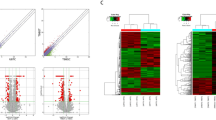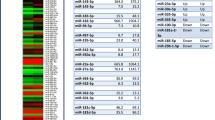Abstract
The hypoxia microenvironment is highly associated with GBM’s malignant phenotypes. CircRNAs were reported involved in GBM’s biological characteristics and regulated by HIF-1α. However, the differential expression profile and role of circRNAs in GBM cells under hypoxia are still unclear. The expression profiles of circRNAs in LN229 and T98G under hypoxia were explored via circRNA sequencing analysis. Those circRNAs significantly dysregulated both in LN229 and T98G and could be found in circBase were selected and validated by qRT-PCR, RNase R digestion reaction, and Sanger sequencing. Normal cell line and fresh GBM tissues were also used for qRT-PCR validation. The roles of differentially expressed circRNAs were evaluated by bioinformatics analyses. There were 672 dysregulated circRNAs in LN229 and 698 dysregulated circRNAs in T98G. GO analysis indicated that the alteration of circRNA expression related to GBM cell’s biogenesis and metabolism. KEGG analysis demonstrated that TGF-β signaling pathway, HIF-1 signaling pathway, and metabolism-related signaling pathway were closely associated with differentially expressed circRNAs under hypoxia. These results were confirmed by GSEA analysis. The 6 selected and dysregulated circRNAs both in LN229 and T98G including hsa_circ_0000745, hsa_circ_0020093, hsa_circ_0020094, hsa_circ_0000943, hsa_circ_0004874, and hsa_circ_0002359 were validated by qRT-PCR. Inhibition of hsa_circ_0000745 inhibited GBM cell’s proliferation, migration, and invasion. HIF-1α centered circRNA-miRNA-mRNA networks analysis showed that the 6 validated circRNAs could cross-talk with 11 related miRNAs. The circRNA expressions are dysregulated in GBM cell under hypoxia. The 6 validated circRNAs could participate in GBM’s development and progression when hypoxia occurs. They might be the candidates for prognostic markers and adjuvant therapeutics of GBM in the future.







Similar content being viewed by others
Data Availability
The raw data supporting the conclusion of this article will be made available by the authors, without undue reservation.
References
Balandeh E et al (2021) Roles of non-coding RNAs and Angiogenesis in Glioblastoma. Front Cell Dev Biol 9:716462
Bartek J Jr et al (2012) Key concepts in glioblastoma therapy. J Neurol Neurosurg Psychiatry 83(7):753–760
Boeckel JN et al (2015) Identification and characterization of hypoxia-regulated endothelial circular RNA. Circ Res 117(10):884–890
Brahimi-Horn MC, Chiche J, Pouyssegur J (2007) Hypoxia and cancer. J Mol Med (berl) 85(12):1301–1307
Cen L et al (2021) Competing endogenous RNA networks in glioma. Front Genet 12:675498
Chen W et al (2019a) Clinical implications of hypoxia-inducible factor-1alpha and caveolin-1 overexpression in isocitrate dehydrogenase-wild type glioblastoma multiforme. Oncol Lett 17(3):2867–2873
Chen LH, Wang LP, Ma XQ (2019b) Circ_SPECC1 enhances the inhibition of miR-526b on downstream KDM4A/YAP1 pathway to regulate the growth and invasion of gastric cancer cells. Biochem Biophys Res Commun 517(2):253–259
Ding X et al (2020) CircRNAs as potential biomarkers for the clinicopathology and prognosis of glioma patients: a meta-analysis. BMC Cancer 20(1):1005
Dunn GP et al (2012) Emerging insights into the molecular and cellular basis of glioblastoma. Genes Dev 26(8):756–784
Eales KL, Hollinshead KE, Tennant DA (2016) Hypoxia and metabolic adaptation of cancer cells. Oncogenesis 5:e190
Furnari FB et al (2007) Malignant astrocytic glioma: genetics, biology, and paths to treatment. Genes Dev 21(21):2683–2710
Guo X, Piao H (2021) Research progress of circRNAs in glioblastoma. Front Cell Dev Biol 9:791892
Hu H et al (2018) Mutational landscape of secondary glioblastoma guides MET-targeted trial in brain tumor Cell 175(6):1665–1678
Huang WJ, Chen WW, Zhang X (2016) Glioblastoma multiforme: effect of hypoxia and hypoxia inducible factors on therapeutic approaches. Oncol Lett 12(4):2283–2288
Jensen RL (2006) Hypoxia in the tumorigenesis of gliomas and as a potential target for therapeutic measures. Neurosurg Focus 20(4):E24
Jiang T et al (2016) CGCG clinical practice guidelines for the management of adult diffuse gliomas. Cancer Lett 375(2):263–273
Jin P et al (2018) CircRNA circHIPK3 serves as a prognostic marker to promote glioma progression by regulating miR-654/IGF2BP3 signaling. Biochem Biophys Res Commun 503(3):1570–1574
Kalkan R (2015) Hypoxia is the driving force behind GBM and could be a new tool in GBM treatment. Crit Rev Eukaryot Gene Expr 25(4):363–369
Korkolopoulou P et al (2004) Hypoxia-inducible factor 1alpha/vascular endothelial growth factor axis in astrocytomas. Associations with microvessel morphometry, proliferation and prognosis. Neuropathol Appl Neurobiol 30(3):267–278
Krock BL, Skuli N, Simon MC (2011) Hypoxia-induced angiogenesis: good and evil. Genes Cancer 2(12):1117–1133
Li Y et al (2021) HNRNPL circularizes ARHGAP35 to produce an oncogenic protein. Adv Sci (weinh) 8(13):2001701
Lo Dico A et al (2018) Hypoxia-inducible factor-1alpha activity as a switch for glioblastoma responsiveness to temozolomide. Front Oncol 8:249
Louis DN et al (2016) The 2016 World Health Organization classification of tumors of the central nervous system: A summary. Acta Neuropathol 131(6):803–820
Lu J et al (2021) CircNUP98 suppresses the maturation of miR-519a-3p in glioblastoma. Front Neurol 12:679745
Luo H et al (2021) circ_PTN contributes to -cisplatin resistance in glioblastoma via PI3K/AKT signaling through the miR-542-3p/PIK3R3 pathway. Mol Ther Nucleic Acids 26:1255–1269
Matsumoto T et al (2020) Requirements of LEFTY and Nodal overexpression for tumor cell survival under hypoxia in glioblastoma. Mol Carcinog 59(12):1409–1419
Mudassar F et al (2020) Targeting tumor hypoxia and mitochondrial metabolism with anti-parasitic drugs to improve radiation response in high-grade gliomas. J Exp Clin Cancer Res 39(1):208
Nabors LB et al (2017) NCCN guidelines insights: central nervous system cancers, Version 1.2017. J Natl Compr Canc Netw 15(11):1331–1345
Ostrom QT et al (2013) CBTRUS statistical report: primary brain and central nervous system tumors diagnosed in the United States in 2006–2010. Neuro Oncol 15(2)ii1–56
Reni M et al (2017) Central nervous system gliomas. Crit Rev Oncol Hematol 113:213–234
Rezaei O et al (2020) Emerging role of long non-coding RNAs in the pathobiology of glioblastoma. Front Oncol 10:625884
Seystahl K et al (2015) Differential regulation of TGF-beta-induced, ALK-5-mediated VEGF release by SMAD2/3 versus SMAD1/5/8 signaling in glioblastoma. Neuro Oncol 17(2):254–265
Shahzad U et al (2021) Noncoding RNAs in glioblastoma: emerging biological concepts and potential therapeutic implications. Cancers Basel 13(7)
Su H et al (2019) Hypoxia-associated circDENND2A promotes glioma aggressiveness by sponging miR-625-5p. Cell Mol Biol Lett 24:24
Tabatabai G et al (2006) Irradiation and hypoxia promote homing of haematopoietic progenitor cells towards gliomas by TGF-beta-dependent HIF-1alpha-mediated induction of CXCL12. Brain 129(Pt 9):2426–2435
Wang R et al (2018) CircNT5E acts as a sponge of miR-422a to promote glioblastoma tumorigenesis. Cancer Res 78(17):4812–4825
Yang L et al (2012) Hypoxia and hypoxia-inducible factors in glioblastoma multiforme progression and therapeutic implications. Exp Cell Res 318(19):2417–2426
Zagzag D et al (2000) Expression of hypoxia-inducible factor 1alpha in brain tumors: association with angiogenesis, invasion, and progression. Cancer 88(11):2606–2618
Zhang Q et al (2020a) Roles of circRNAs in the tumour microenvironment. Mol Cancer 19(1):14
Zhang B et al (2020b) Circ-SPECC1 modulates TGFbeta2 and autophagy under oxidative stress by sponging miR-33a to promote hepatocellular carcinoma tumorigenesis. Cancer Med 9(16):5999–6008
Funding
This work was supported by the National Natural Science Foundation of China (grant number: 81902521), Shanghai Sailing Program (grant number: 19YF1432800), and Research Project of Xinhua Hospital (grant number: XH1936).
Author information
Authors and Affiliations
Contributions
Ming Chen and Fei Wang designed and supervised the project. Zheng Chen, Shaohua Su, and Min Yang conducted the experiments and performed data analysis. Zheng Chen wrote and revised the manuscript.
Corresponding authors
Ethics declarations
Conflict of Interest
The authors declare no competing interests.
Additional information
Publisher's Note
Springer Nature remains neutral with regard to jurisdictional claims in published maps and institutional affiliations.
Supplementary Information
Below is the link to the electronic supplementary material.
Rights and permissions
Springer Nature or its licensor (e.g. a society or other partner) holds exclusive rights to this article under a publishing agreement with the author(s) or other rightsholder(s); author self-archiving of the accepted manuscript version of this article is solely governed by the terms of such publishing agreement and applicable law.
About this article
Cite this article
Chen, Z., Su, S., Yang, M. et al. Profiling and Bioinformatics Analyses of Differential Circular RNA Expression in Glioblastoma Multiforme Cells Under Hypoxia. J Mol Neurosci 72, 2451–2463 (2022). https://doi.org/10.1007/s12031-022-02090-y
Received:
Accepted:
Published:
Issue Date:
DOI: https://doi.org/10.1007/s12031-022-02090-y




